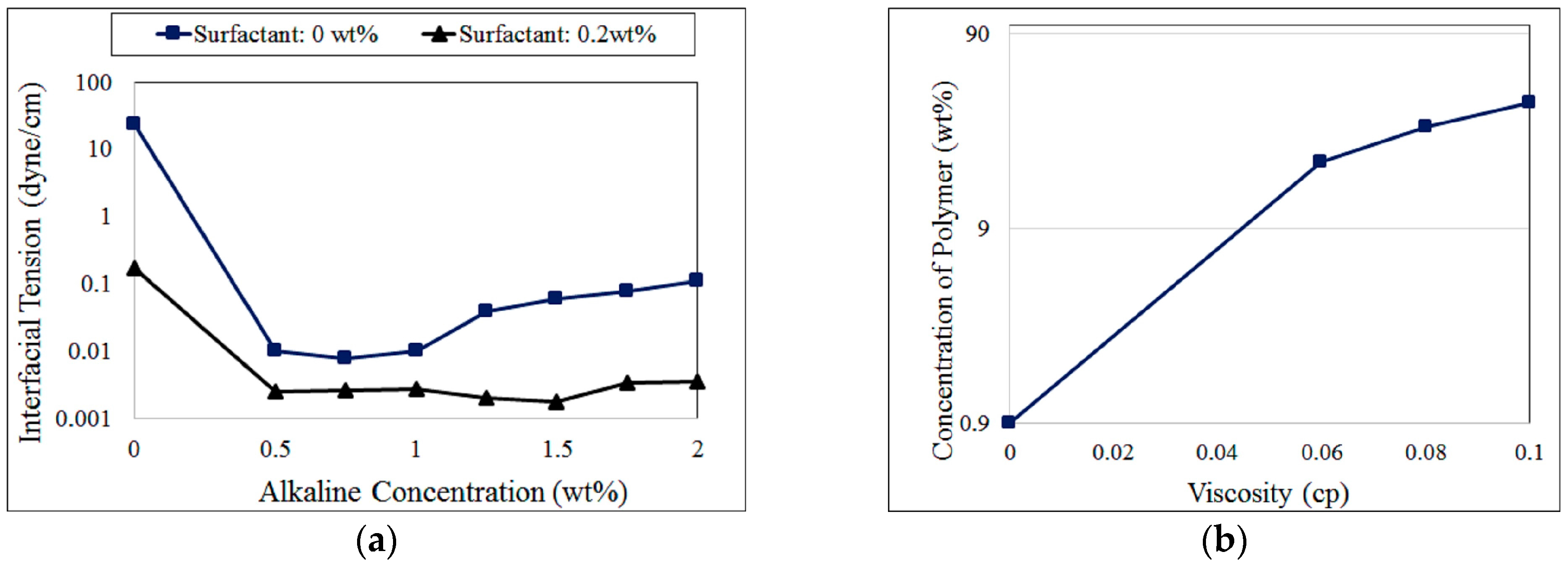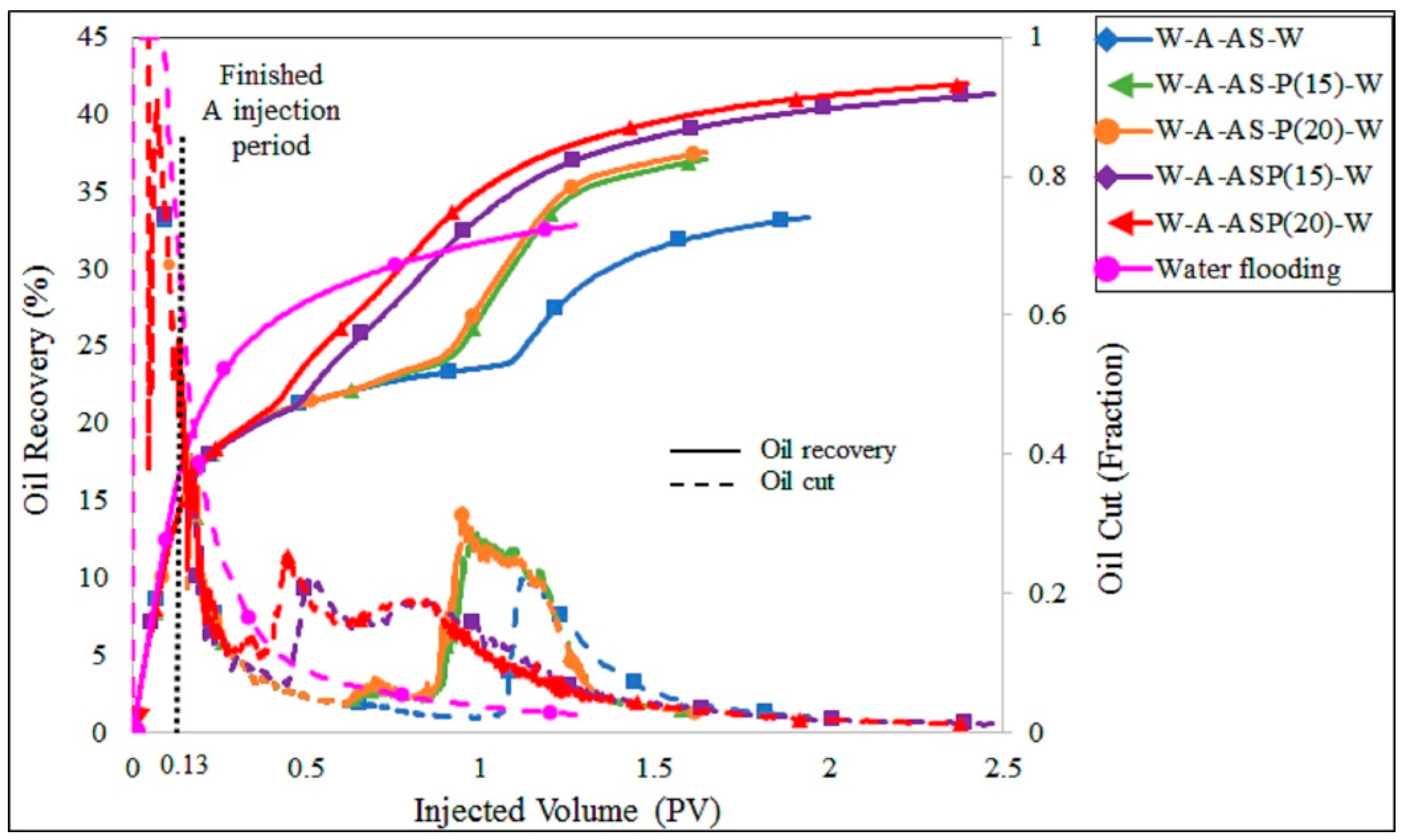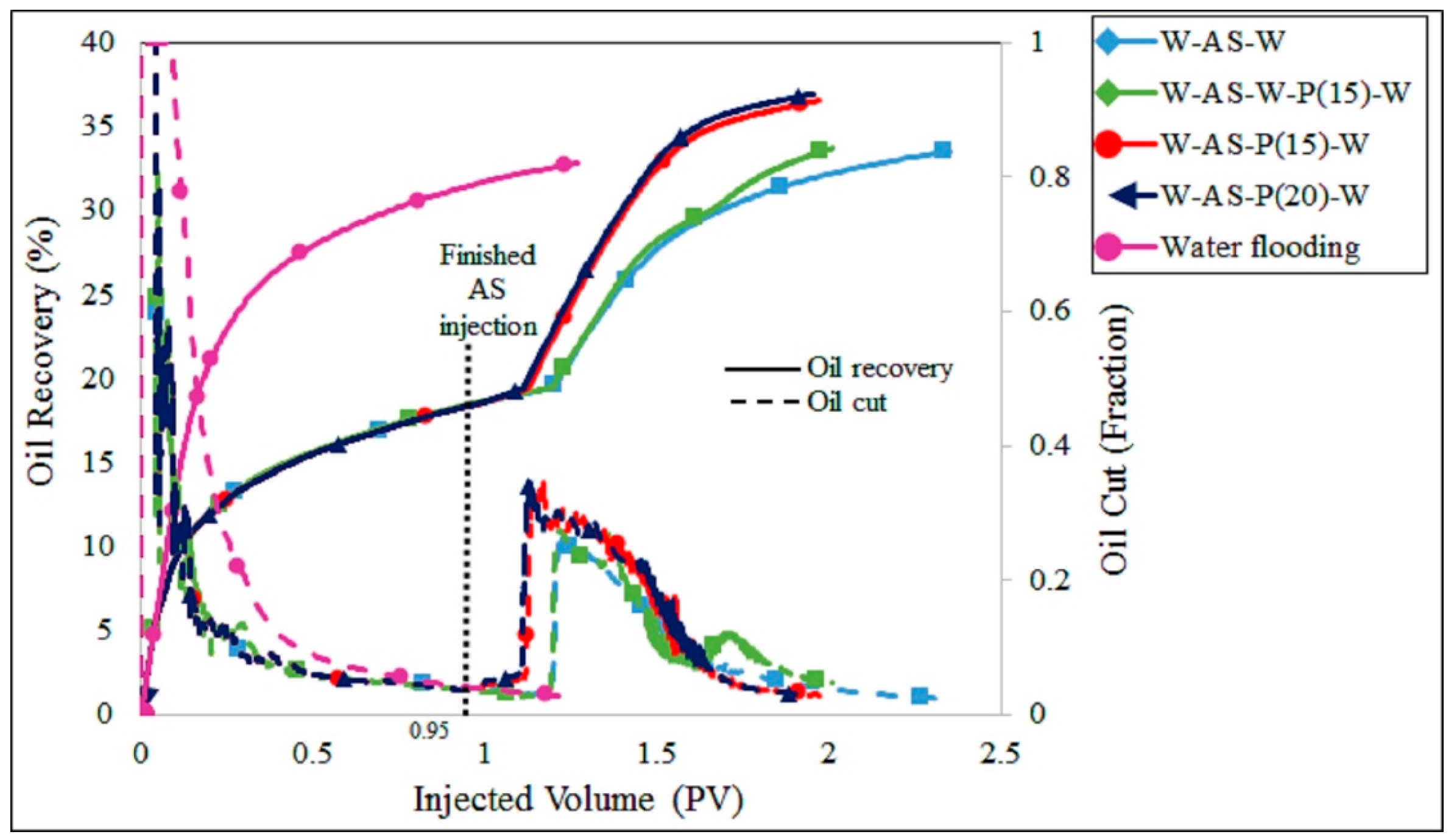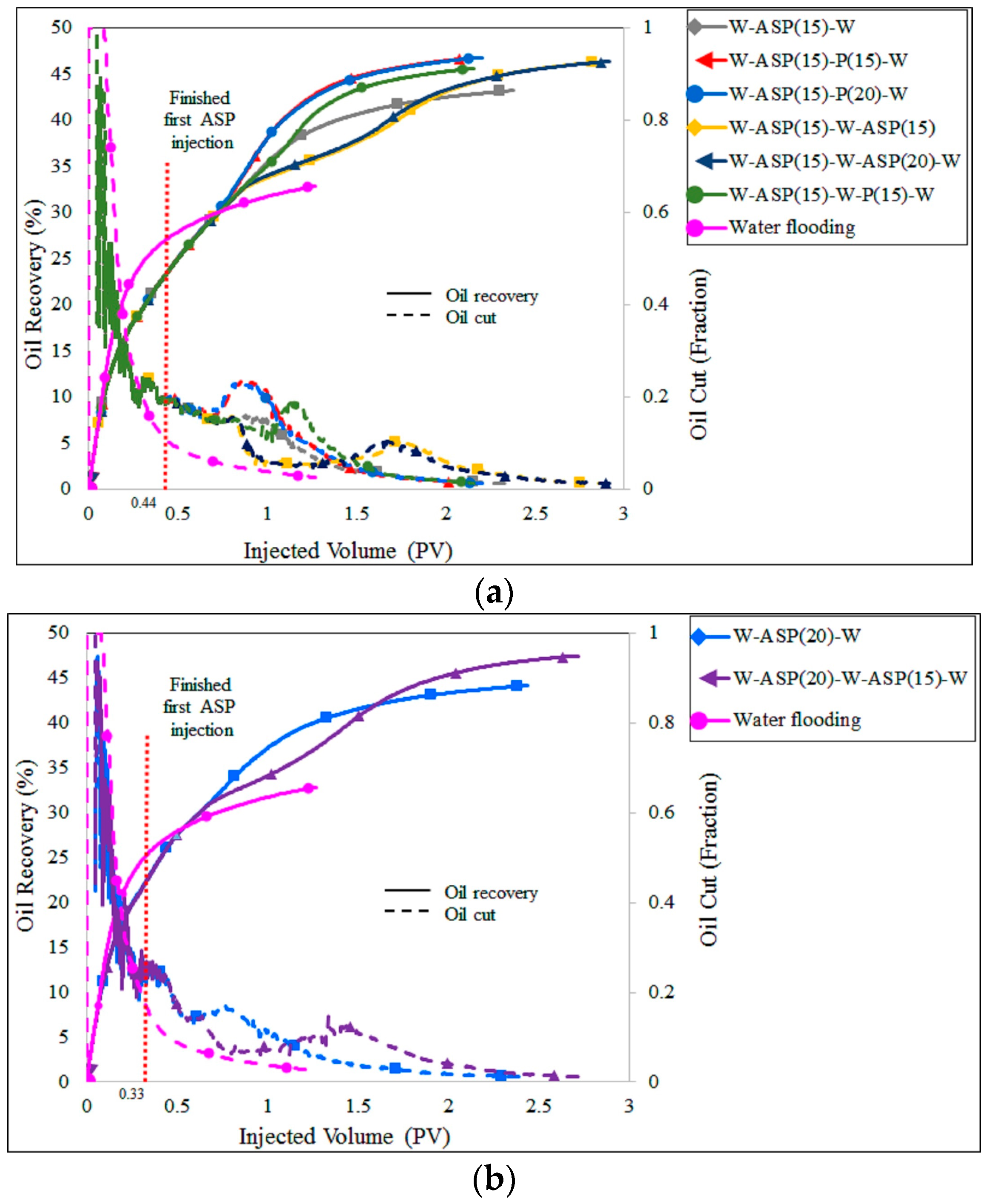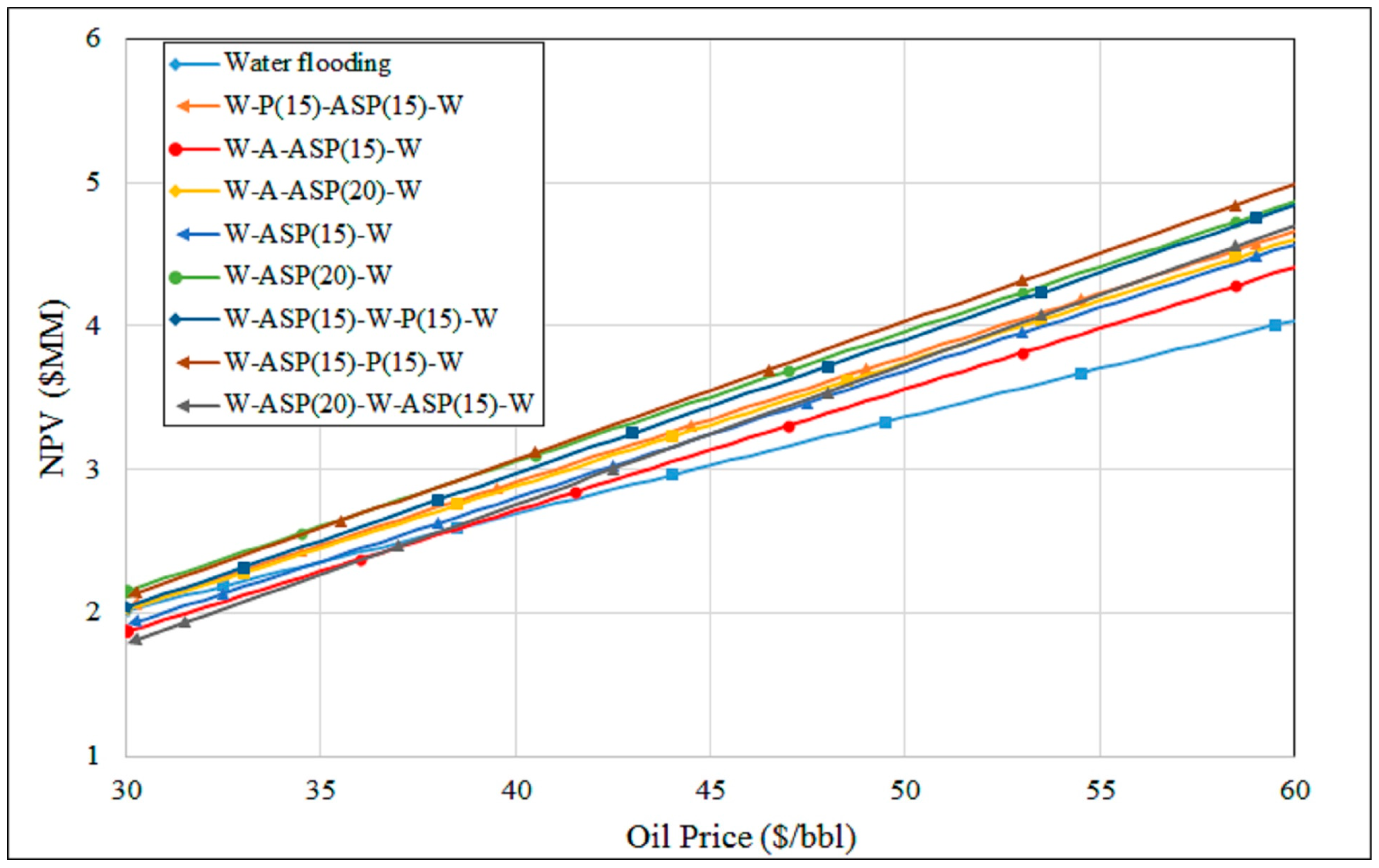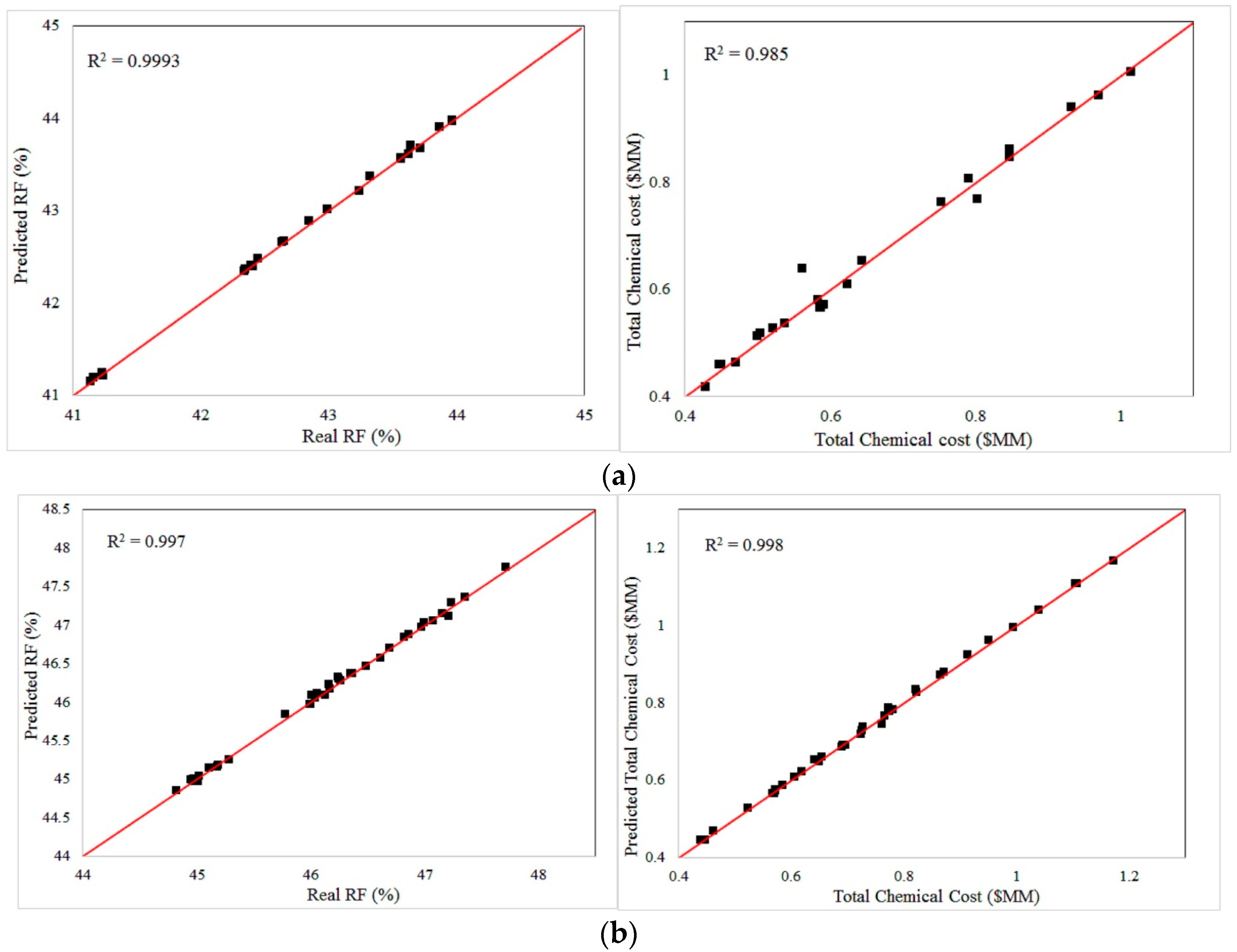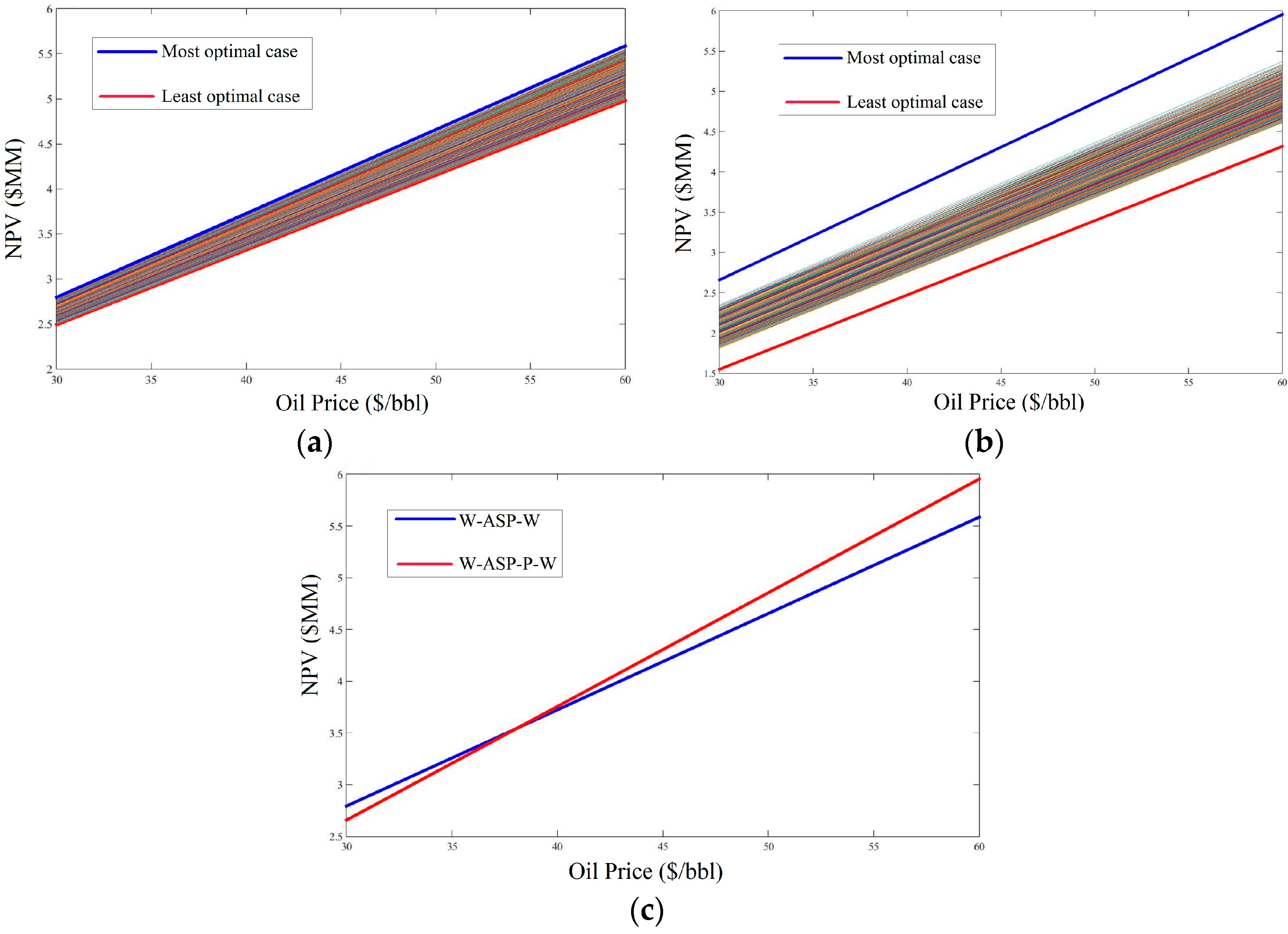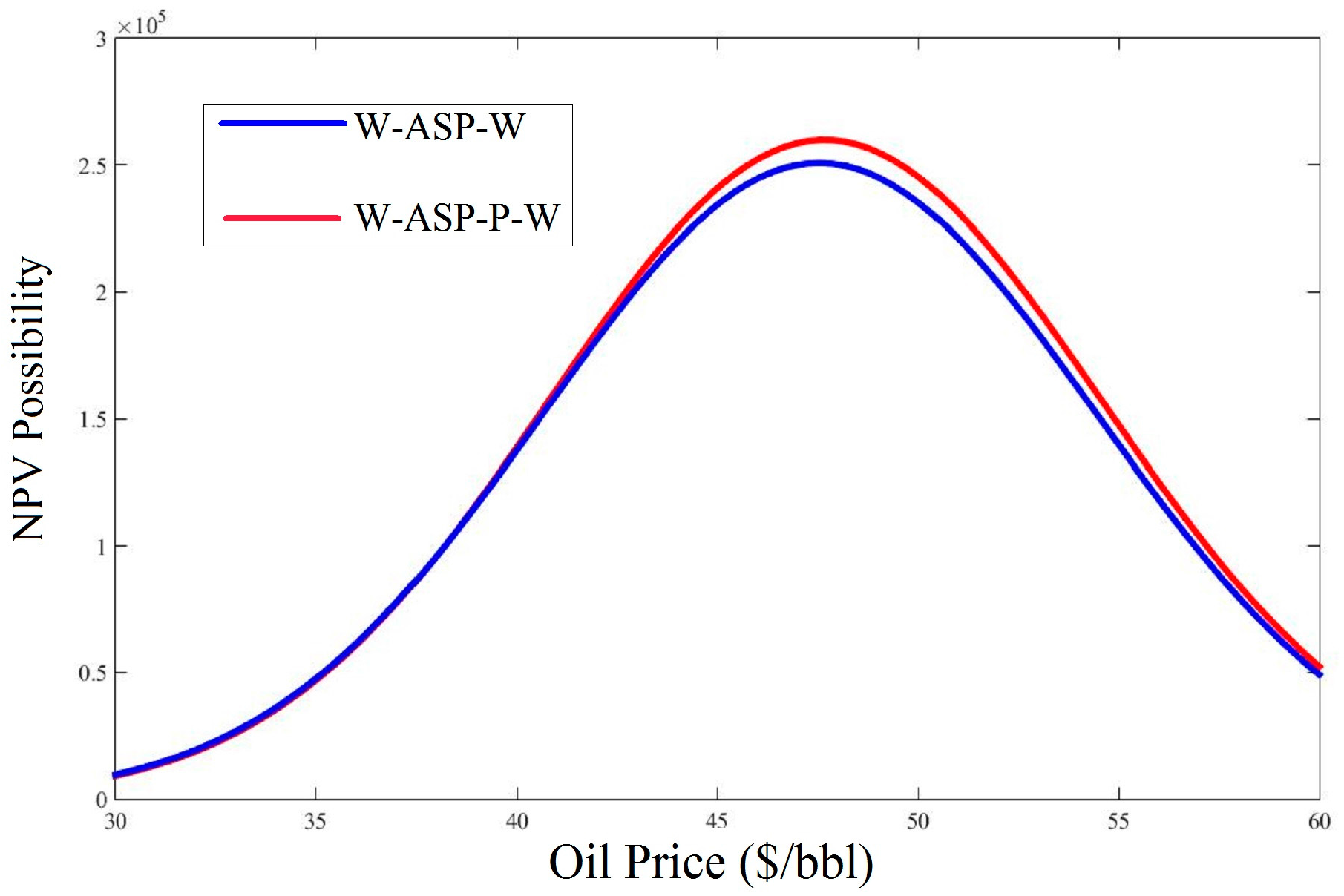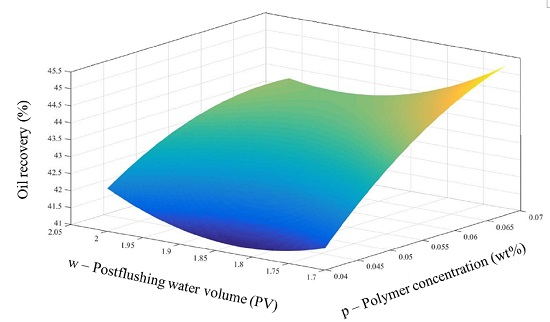1. Introduction
Heavy oil is one of the major commercial deposits on Earth, with the three largest reserves belonging to Russia, Canada and Venezuela; in particular this type of crude oil is the main resource in Northern Alberta in Canada [
1,
2]. Basically, heavy oil is defined as crude oil which has a viscosity ranging from 100 to 10,000 cp and gravity smaller than 20
oAPI; thus, the requisite oil recovery methods face many challenges compared to those used for conventional oil reservoirs [
1]. Recently, the utilization of chemical flooding has become an attractive and feasible method for recovering a large volume of heavy oil when the traditional thermal methods are not suitable, as in the case of thin pay-zone reservoirs or when overlying permafrost exists [
3]. Many previous works have demonstrated the proper applications of alkaline (A)–surfactant (S)–polymer (P) injections in the Enhanced Oil Recovery (EOR) stage for both conventional and heavy-oil reservoirs. Atsenuwa, et al. classified heavy oil with viscosities that ranged from 50 to 50,000 cp, they pointed out that the capillary forces between water and heavy oil are higher than those between water and light oil [
4]. Asghari and Nakutnyy carried out experimental work on the application of polyacrylamide for extracting heavy oil; they concluded that a polymer concentration in the injected fluid higher than 5000 ppm is required to effectively recover oil for injection rates of less than 29.6 m
3/day [
5]. Nevertheless, by using polymer with viscosities in the range of 2000–5000 cp to sweep the trapped oil by core-flood tests, Bodino et al. observed an insignificant increase in the recovery factor when the viscosity of the polymer solution was changed from 3 to 60 cp [
6]. In terms of the use in offshore heavy-oil reservoirs, Kang and Jian presented the main problems on oil recovery and concluded that the water salinity was the most important factor affecting the success of polymer flooding processes [
7]. Alsofi et al. demonstrated that the streamline simulation scheme showed better performance than the conventional simulation scheme for polymer core-flood tests; further, they determined that the polymer solution should be injected as soon as possible before any water flooding for achieving the best outcomes [
8]. In contrast, Zhou et al. conducted experiments on various chemical flooding sequences and showed the importance of a second polymer slug after the first chemical injection with an injected water slug in between [
9]. They also found that the polymer was the most dominant element in chemical flooding, and the polymer concentration was the crucial factor in enhanced heavy oil recovery. Even though core-flood tests are always carried out in laboratories before executing any pilot tests in the field, Yooybari et al. found that prediction of the oil recovery using core-flood investigations was unreliable compared to the use of field measurements; they stressed that the most important part of a successful polymer flooding process must be derived on the basis of the screening procedures from the viewpoints of either technical or economic feasibility [
10].
Although the utilization of polymer mainly aims to improve the sweep efficiency by properly controlling the mobility of the displacing fluids, alkali and surfactant were also considered as the most effective agents for making the oil moveable by reducing the interfacial tension (IFT) between oil and water (O-W). Dong et al. investigated the displacement mechanisms of alkaline–surfactant flooding by using the glass micromodel, the results showed that alkaline injection formed the water-in-oil (W/O) emulsion and effectively blocked the water channels, therefore improved the sweep efficiency; furthermore, the addition of a dilute surfactant to an alkaline solution could form an oil-in-water (O/W) emulsion, which makes the heavy-oil droplets moveable [
11]. Theoretically, alkali generates an in-situ surfactant in the reservoir by reacting with the natural acid components of the oil, and this agent also can partly alter the rock wettability in some specific rock systems [
12,
13]. Pei et al. demonstrated the highly sensitive effects of alkali on the IFT properties for heavy oil with low acid number compared to the oil with high acid number [
14]. In their experimental works, they also determined a cost-effective EOR process when utilizing alkaline flooding for acidic heavy-oil reservoira; in particular, Na
2CO
3 performed better than NaOH in terms of lowering the IFT value. Basically, the combination of alkali, surfactant, and polymer in appropriate concentrations helps to drastically improve the heavy oil production compared to the use of individual agents [
15,
16,
17]. In the work of Luo et al., surfactant–polymer flooding has been demonstrated to be a favorable combination for a heavy-oil sample from Western Canada when the alkaline solution was prone to cause severe scaling near the wellbore region; they determined that it was difficult to form the O/W emulsion with a SP system owing to its high viscosity, thereby decreasing the oil recovery enhancement level [
18]. Further, the work of Feng et al. affirmed the ineffective application of the combined ASP flooding due to the severe problems of emulsification as well as precipitation [
19]. Moreover, SP flooding could increase the recovery factor by 13%–20%, which was significantly higher than single polymer flooding under the same conditions. However, they found that only the surfactant could not reduce the IFT between O-W to the desired ultralow value. On the contrary, the combined ASP flooding was demonstrated to be more attractive than SP flooding in the work of Bataweel and Nasr-EI-Din in terms of reaching the ultralow IFT and high tertiary heavy oil recovery [
20]. Therefore, the most effective combinations so far are still of concern owing to the dependences on the reservoir conditions, oil properties, laboratory testing conditions, and feasible practical application in the field.
Among the disputes concerning chemical use, there are controversies regarding the use of optimization algorithms as they must be perfectly applied to obtain the highest profit or maximize the ultimate oil recovery with the lowest time and cost expenses. The work of Zerpa et al. evaluated the optimization algorithms of surrogate models for various scenarios of ASP flooding in terms of the objective function and oil recovery factor for conventional oil reservoirs. They investigated the use of multiple surrogates for identifying alternative optimal solutions corresponding to different regions of the design space [
21]. Moreover, the response surface approach for ASP flooding proposed by Zerpa et al. proved to be an effective mathematic methodology for optimizing the chemical slug size in comparison with the suggested volume from a laboratory design [
22]. Regarding real applications in the field, a response surface has been considered to optimize the alkali and surfactant concentrations in the clastic reservoir of the Angsi field in the Malay basin, as in the published works of Ghadami et al. [
23]. They concluded that it was not necessary to take into account all of the parameters in the sensitivity analysis; instead, only the effects of the important designed chemical parameters such as the chemical concentrations, initiation time, or slug sizes needed to be investigated. Although there are few published works that use the RSM methods in the sensitivity analysis and optimization of chemical flooding so far, this mathematical tool has been successfully applied in other geological uncertainty processes. The main effect method which displays first-order Sobol indices for the response surface was used for uncertainty and sensitivity analysis on assessing the CO
2 injectivity, area of review and gas migration rate in the work of Dai et al. for carbon sequestration [
24]. In the recent research of Dai et al. the response surface analysis was conducted by using the multi-variate adaptive regression spline for the risk factor metric in CO
2 injection and storage [
25]. From the results, the obtained coefficients of determination, R
2, were higher than 0.95 and absolutely indicated the reliable representation of the response models for evaluating the interactions of CO
2, oil, gas and brine water for CO
2-EOR environmental issues. Moreover, the study of Pan et al. about uncertainty analysis of CO
2-EOR processes concluded that the determination value R
2 larger than 0.9 was acceptable for predicting the physical behaviors of the processes by the integrated RSM and Monte Carlo algorithms [
26].
As there are many controversies regarding the utilization of chemicals for viscous oil recovery, this work investigates the flooding performances of different potentially combined chemical agents for the enhanced heavy-oil recovery by numerical studies in order to determine the most efficient combination for specific reservoir conditions. A heavy-oil reservoir model with quarter five-spot pattern is in the STARS simulator of the Computed Modelling Group (CMG). Both the injector and producer are horizontal wells installed in the near-bottom layers owing to the high productivity [
27]. All possible potential chemical flooding sequences are grouped and investigated separately before carrying out the pre-evaluation stage where the general commercial assessments are primarily considered. The fixed chemical costs and the variation in the oil price are proposed for the economic pre-evaluation instead of fully applying the financial terms of the project. In the economic post-evaluation, the quadratic response surface models are applied for the purpose of optimizing the final net present value (NPV) as well as the uncertainty of the calculated NPV according to the oil price variation.
Practically, the consideration of both technical and economic aspects—as in this work—assist considerably in understanding the performances of disparate flooding processes, thereafter properly selecting the most outstanding flooding sequences, and finally contributing to comprehensive evaluations for the uncertainty analysis. As there has been no published consideration of an RSM for the optimization of enhanced heavy oil recovery by chemical flooding, the novel approach described in this work will promisingly contribute to the real project assessment with a simpler but still effective tool. Moreover, as the chemical flooding processes have been integrated into the STARS simulator and demonstrated to have high accuracy level of simulation by previous works [
28], the three-dimension (3D) numerical results of this study can be certainly acceptable and reliable for reference by the industry.
3. Flooding Strategies
Many previous works have demonstrated successful injection plans by using either single or combined chemical flooding to improve heavy-oil production. A very early pilot test in the Gudong oil field including four injectors and nine producers observed successful results, in which the ultimate oil recovery by ASP flooding increased by 13.4% compared to water flooding, where the oil recover rate could reach 76.6 t/day [
30]. The later commercial tests of ASP flooding in the Central Xinger area of the Daqing oil field with a total of 45 wells also demonstrated satisfactory production performance, where the oil rate could be up to 180 t/d and the obtained oil recovery by ASP flooding was nearly 21.52% of the original oil in place (OOIP) [
31]. Further, the most recent report in 2014 of
Oil & Gas Journal presented the officially successful polymer flooding projects in the Pelican Lake field, with a total oil production rate higher than 3180 m
3/day. With thin pay zones and highly viscous oil properties, the utilization of chemical flooding has been proposed to extract the crude oil in the west-central part of Saskatchewan (Canada) as the thermal method is unsuitable and water flooding could only recover 8.5% of the OOIP in some reservoirs [
18].
Theoretically, the use of alkali aims to generate an in-situ surfactant/soap by reacting with the natural acids in oil in order to reduce the IFT between O-W, which makes the removal of crude oil easier thereafter [
32,
33]. Furthermore, the penetration of the alkaline solution into the crude oil causes the formation of a W/O emulsion, thereby reducing the mobility of the displacing fluids and diverting the injected fluids into the unswept region, resulting in an improvement in the sweep efficiency [
34]. A synthetic surfactant is mainly employed to reduce the IFT between O-W by forming a microemulsion with a limited range of concentrations [
35]. The combination of alkali and the synthetic surfactant (AS) helps to reduce the IFT between O-W in higher level, thereby remedying the issues of alone alkaline injection, such as generating insufficient IFT reduction due to the lack of the in-situ generated surfactant due to low acid contents in oil [
36]. However, the injected fluids for AS flooding still have very low viscosity compared with that of crude oil; therefore, the improvement in the mobility is not considerable to sweep the reservoir thoroughly, and causing the water channel as a consequence. The injection of the polymer solution is a unique method for increasing the viscosity of the displacing fluids, thereby significantly improving the sweep efficiency as a result of better mobility control and water channel mitigation. In addition, in a multi-layer system, the injected water containing polymer also develops the crossflow between the low- and high-permeability layers that is resulted from the shear-thinning behavior of the polymer solution [
37]. The contemporary injection of alkali, synthetic surfactant, or both of them with the polymer solution will increase the displacement efficiency as the result of the IFT reduction at high level, combining with the improvement on the sweep efficiency by enlarging the oil swept area caused by blocking the water channel assistant, thereby enhancing the final oil recovery [
38]. In summary, the most relevant possibility for combined chemical injection can basically be AS or ASP solutions. Further, the fluid slug injected after the preflushing water and before the final postflushing water should also be taken into consider in order to perfectly enhance the flooding performance.
Artificial water (or simply “water”) is generated by adding salt to clean water. The base cases of the flooding strategies for all sequences are presented in
Table 2. Principally, all sequences are initiated with a preflushing water slug and terminated with a postflushing water slug. The concentrations of the individual flood types are designed as follows:
- ▪
Water flooding: complete water injection throughout the project.
- ▪
A—2.08% in volume (vol %) alkali in the solution.
- ▪
AS—(proceeding after A) 3.9 vol % alkali combined with 4.2 vol % surfactant in the solution.
- ▪
AS—(proceeding after W) 1.68 vol % alkali combined with 0.04 vol % surfactant in the solution.
- ▪
ASP(15)—2.12 vol % alkali combined with 0.132 vol % surfactant and 540-ppm polymer in the solution. Initially, the fluid has a viscosity of nearly 15 cp.
- ▪
ASP(20)—2.12 vol % alkali combined with 0.132 vol % surfactant and 680-ppm polymer in the solution. Initially, the fluid has a viscosity of approximately 20 cp.
- ▪
P(15)—550-ppm polymer in the solution. Initially, the fluid has a viscosity of approximately 15 cp.
- ▪
P(20)—690-ppm polymer in the solution. Initially, the fluid has a viscosity of nearly 20 cp.
On the basis of the first chemical slug type after preflushing with water, the flooding sequences can be divided into four main groups of flooding, namely (A), (AS), (ASP), and (P), as presented in
Table 2. These groups are analyzed separately before being considered for a comprehensive evaluation. The similar injection strategies in each group with a final oil rate of 1.59 m
3/day were proposed in order to better compare the effectiveness of the chemical changes in the sequences. The specific concentrations of the flood types were selected on the basis of the results of IFT measurements and the viscosity of the injection fluids.
Figure 1 shows the fundamental chemical properties used for the simulation studies including the IFT characteristics and the viscosity behavior of the polymer solution. On the basis of the chemical data, the wettability condition of rock-fluid properties will be changed according to the interpolation scheme of the simulator when surfactant concentration increases. In detail, the addition of surfactant causes a reduction of IFT and an increase of capillary number, therefore lowering the residual oil saturation and straightening the relative permeability curves [
39].
Following the default sets of critical capillary number in STARS (CMG), the residual oil saturation of zero can be obtained from the capillary number (Nc) of 1.2 × 10−3 and the relative permeability curves can become straight line when Nc reaches 2.3 × 10−1.
The relative permeability curves for the initial conditions and after being interpolated are presented in
Figure 2.
